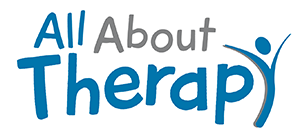One of the most common pediatric concerns we encounter in Occupational Therapy is handwriting. Often, our kids with special needs have a lot of trouble learning even basic printing skills. Neatness, letter sizing, spacing, and writing speed are all common problem areas. Read on to learn how Occupational Therapy can help with handwriting and how parents can support their child’s progress at home.
Usually between 2 – 3 years old, children become aware of letters and may try to write them. Parents should not try to pressure children this age into practicing, but can support their child by providing ample opportunities to color and draw. Encourage your child to try both the left and right hands. After the third birthday, parents may help their child with a proper pencil grasp. If your child has sensory processing issues or has trouble learning how to hold his fingers, try this handy tip using an old sock. (click the link to read the article)
If your older preschooler isn’t showing a lot of interest in writing, it’s time to try some games. Check out this mom’s blog for some brilliant ideas to make things more interesting!
Being able to write by hand requires a tremendous amount of fine motor skills as well as strong connections between the brain and the hands. Also needed is the ability to sit and focus for at least a few minutes at a time. For many of our children with special needs, these skills and abilities need to be developed with the help of an Occupational Therapist.
If you know your child struggles with handwriting, I encourage you seek an evaluation from an Occupational Therapist. An O.T. is trained to determine exactly which skills need attention. Often, a handwriting system, such as Handwriting Without Tears, can be used during therapy sessions and also sent home with the child and his parents.
There are many inexpensive tools that can help a child who is struggling with proper pencil grasp. Some are specially sized or designed writing instruments, and others are pencil grips for use with standard pencils and pens. Ask your child’s therapist which ones would work best for his needs.
Another fun and inexpensive tool to help your child develop precision and strength with his writing hand is to use large, over sized plastic tweezers and some small objects. These can usually be found at a homeschool or educational supply store. Make a game out of seeing who can use the tweezers to pick up the most items and transfer them to a cup.
If your child is school-aged, and especially if he has an IEP, I recommend the school O.T. evaluate any handwriting concerns. For children who are not able to learn to write well, assistive technology is available. One of my children, a 7th grader, has a school-issued assistive device to use in class and bring home for homework. His IEP specifies exactly how and when he is allowed to use it. For him, this has been a tremendous help!
Feel free to contact us at All About Therapy if you would like an in-home evaluation for your child. Call us at: 919-448-6018.
